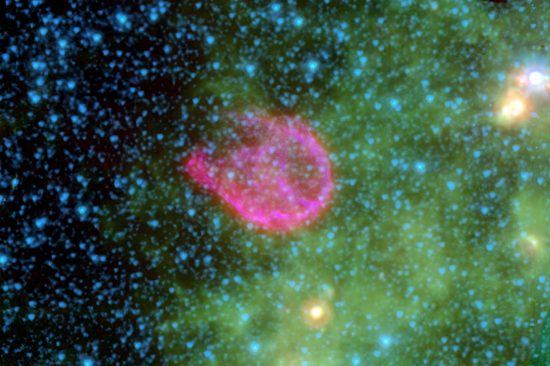
April 24, 2020
A bubble of X-rays generated by an electric discharge through dusty plasma.
In images from the Chandra X-Ray Observatory, a stellar explosion is thought to create a spherical shockwave that is traveling through the surrounding interstellar dust at extremely high velocity. According to astronomers, the shockwave of compressed gas created temperatures so high that several frequencies of X-ray are detected.
One unusual aspect to this particular supernova remnant is that it is rich in oxygen isotopes, something not normally present in interstellar nebulae or “gas bubbles”. It is the explosion of such large stars that is supposed to be responsible for the creation of all the elements in the Universe beyond the simplest isotopes of hydrogen and helium. Indeed, as conventional theories presume, the vast majority of what makes up planets, moons and planetesimals orbiting other stars was forged through fusion as they “burned-up” their hydrogen fuel and converted it into heavier elements.
Once the process created enough iron “ash” in the core, the star no longer supported its thermonuclear engine and it exploded, throwing atomic debris into the galaxy. It is that hypothetical process that produces shockwaves in giant dust clouds, initiating further star formation as a chain-reaction in the galaxy.
As written in prior Pictures of the Day, the Universe is not strictly mechanistic, where things happen only when there are explosions, shockwaves, compressed gas, rebound, expansion or other kinetic and gravity-based forces. Rather, the Universe is crackling with seething energies that exceed the powers of gravity and inertia by many orders of magnitude.
It is electric currents in plasma that create celestial phenomena. It is responsible for the abundant oxygen that is revealed in the green regions of N132D. Rather than an expanding shock wave of gases, N132D is lit by electricity passing through the plasma. The X-ray radiation is typical of that given off by highly excited stars, indicating extremely strong electrical stress. The electric current generates X-rays when it passes through heavy ions in the plasma.
In an Electric Universe, all stars synthesize elements in the concentrated plasma discharges of their photospheres. Supernovae are the result of a star effectively “throwing a switch” in the galactic circuit. The result is the same as an unintended circuit break in an earthly power grid where the stored electromagnetic energy of the entire circuit is suddenly focused at one point.
Stephen Smith
The Thunderbolts Picture of the Day is generously supported by the Mainwaring Archive Foundation.












